Egyptian Painting and Plastic Art
Relief figures, paintings and borders from a sarcophagus and temple columns

Egyptian Architecture and Painting
Capitals (sylised palms and papyrus), cornice and paintings from pylon, entablature, Luxor and Thebes temples, tomb chambers and mummy case
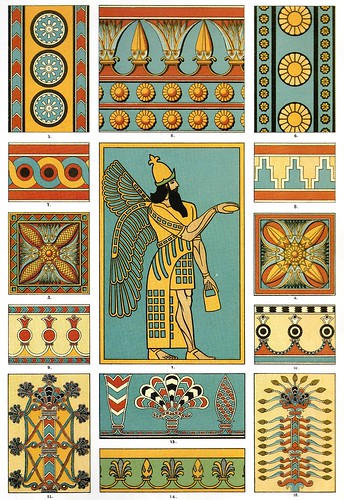
Assyrian Painting Polychrome Sculpture Pottery
Details from bas-reliefs, glazed and enamelled bricks and painted ornament found at Khorsabad, Koyunjik and Nimroud
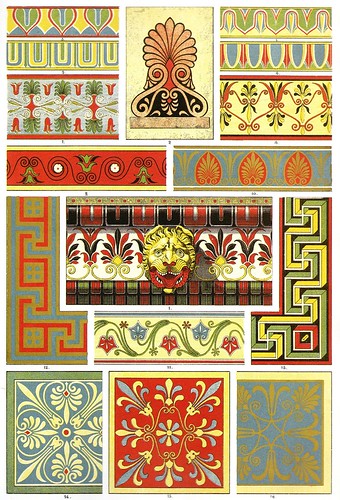
Greek Polychrome Architecture
Friezes, cassette panels, cornices and painted ornament from Selinus, Propylaea and the temple of Nike Apteros and other sites in Athens
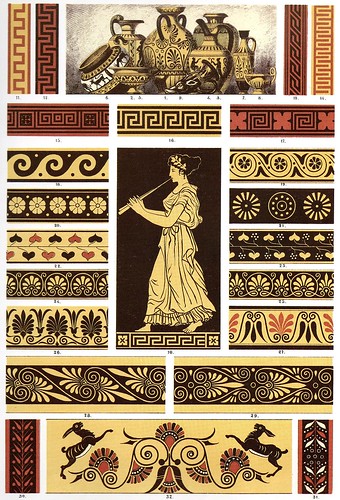
Greek Pottery
Wine amphora, drinking vessels and vases. "The oldest Greek vases are the most simply decorated; on a light ground colour of clay bands, circles, squares etc. used to be painted. But soon they appear also with friezes, decorated with figures of animals. [..] Subsequently figural representations appear between bands: undulating lines, heart-shapes and laurel leaves, meanders etc. [..] In the zenith of Greek ceramique art the colouring of the ground and of the ornamental and figural representations underwent a change. The orange colour of the clay was spared, the bacground filled with black. The figures, drawn with the brush, show much firmness and a noble elegance." {this snip gives a rough indication of the translational quality, such as it is, of the book}
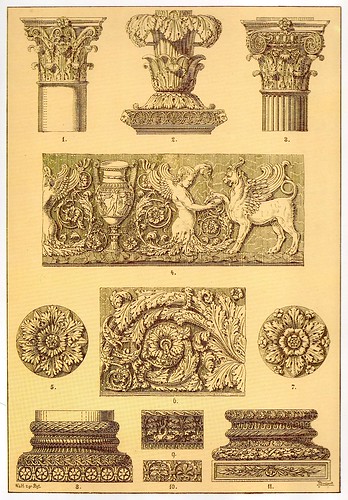
Roman Ornamental Architecture and Sculpture
Friezes, capitals, candelabra, rosettes and cornices - mainly corinthian with some composite and mixed corinthian/ionic features
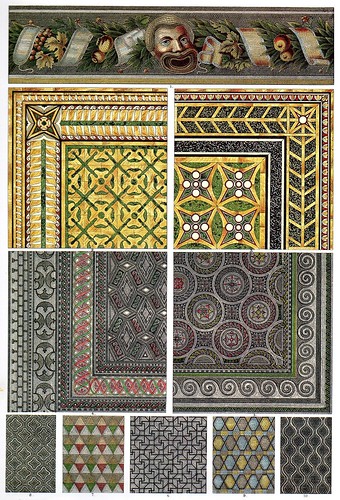
Roman Mosaic Floors
Frieze, floor and plate-mosaics, many originating in Pompeii
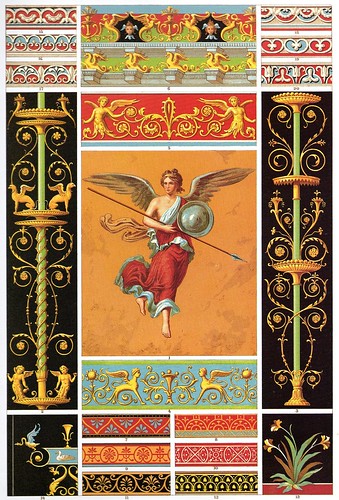
Pompeian Wallpainting and Polychrome Basso Relievos
The wallpaintings found at Pompeii, Herculaneum and Stabiae (and Rome) are probably reproductions of originals - now lost - by the Greek masters

Chinese Painting
Porcelain painting: The principal native plants used for decorative patterns are the leaves and flowers from the tea-shrub, roses, camellias, melons etc.

Chinese Painting Weaving Embroidery and Email Cloisonné*
Vases, bowls, wooden chest and curtain designs (cloisonné is a technique where outlines of the scenes are formed by soldered metal borders and enamelling takes place within each resulting 'cell')
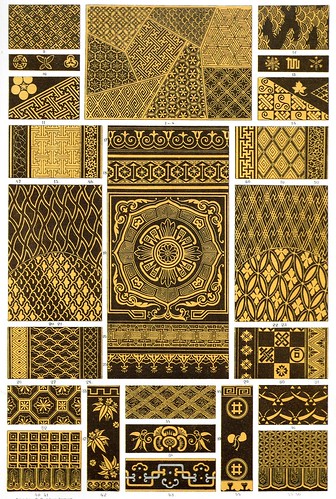
Japan Lacker Painting [sic]
Where Chinese lacquer ware designs are dominated by scenes from nature, the Japanese art more often employs geometric patterns. The most precious papier-mâché and wooden objects have up to twenty coats of lacquer applied, often with reapplication of the design in gold paint (gilding) in between each layer of lacquer, resulting in a 'relief' appearance
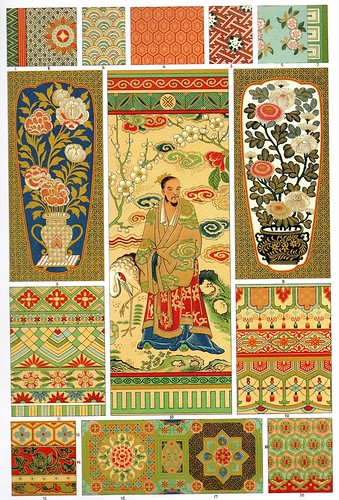
Japan Weaving, Painting and Email Cloisonné
Porcelain and enamelled vases and border patterns from silk.

Indian Metal Work
Etched and damascened ornament/decoration on battle axes, inlaid rhino skin shield and various copper and tin vessels (including a hookah)
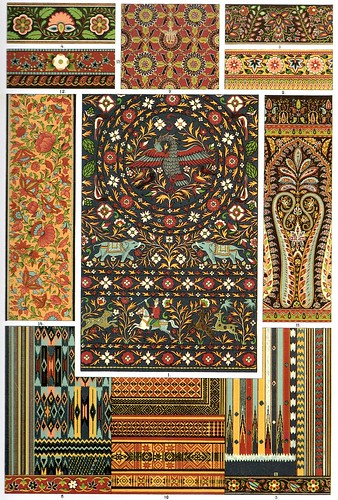
Indian Embroidery, Weaving, Plaiting and Lacquerwork [sic]
Carpets, plaited rush mat, cashmere shawl, painted lacquer and embroidered silk. Primary natural motives include the lotus and palm branch

Indian Metal Work, Embroidery, Weaving and Painting
Chiselled, enamelled and jewelled arms, embroidered fans, table cover, saddle cloth and parasol; woven shawl and woven material borders, lacquer bookcover and illuminated manuscript designs.
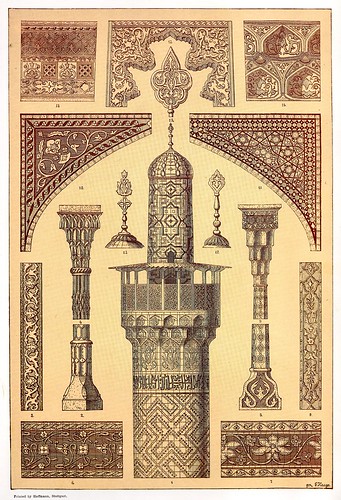
Persian Architecture
Entablature, window frame, column capitals, minaret and various architectural details (all from Isfahan*)
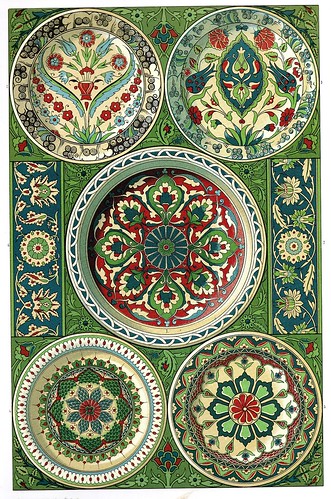
Persian Pottery
Fayence (tin-glazed) plates and wall wainscot borders. "Both the invariably flat treatment of the ornament and the prevalence of the natural imitation of flowers constitute the characteristic style of Persian decoration."
This is the first of three or maybe four posts presenting scans (by me) from 'The Treasury of Ornament' by Heinrich Dolmetsch, first published as 'Der Ornamentenschatz' by Verlag von Julius Hoffman in Stuttgart in 1887.
The book is fairly fragile and I can't of course pull it apart, so it's difficult to get the highest grade quality: there's some focus anomalies at the edges at times but overall I don't think it's too bad. I'll probably end up scanning about three quarters of the total plates.
UPDATE:
- The Treasury of Ornament 2
- The Treasury of Ornament 3
- Online: English / German - (thank V.T.) October 2018
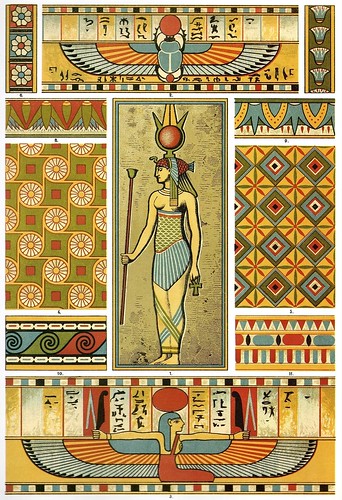



















12 comments :
I really enjoyed this post, P. Great find!
another great post. thank you!
Interesting. I've got Owen Jones' "Grammar of Ornament" that seems to overlap significantly with this. Was one inspired by the other?
Thanks.
Adam, I was going to get into the background a bit more next time (or the one after that), but yeah, for sure, it brings Jones to mind. It's no rip off (so I believe: although I haven't actually gone to specifically check image similarities myself yet) but obviously anything after Jones on this general subject drew inspiration from him.
these cultures are amazing!
I was going to inquire about Jones as well. But instead I'll note that I hadn't realized "email" was a technical term for enamel in English... I did discover awhile back that it means enamel in Czech. (This would be a good argument for spelling the other kind of email "e-mail" but I think that spelling has already faded away.)
These images are just gorgeous. Thanks for taking the personal work to get them online.
before i read your notes, i thought i was looking at owen jones and liking it for the first time!
interesting that every entry, however, fits neatly into the time's preference of 'aesthetic style.'
does this one include japan? (the jones one does not)
Thank you so much for this. These are absolutely gorgeous, and I'm so glad to be able to see them.
have you seen that taschen published a book on ornament after these two encyclopedia : Racinet's L'Ornement polychrome Volumes I and II (1875-1888) and Dupont-Auberville's L'Ornement des tissus (1877).
http://www.taschen.com/pages/en/catalogue/classics/all/44806/facts.the_world_of_ornament.htm
I love your blog by the way, thanks for bringing great stuff to us.
Thanks Rahanhulk. I had noticed the Taschen publication a couple of months ago: I think I either mentioned it on Twitter or shared it via Greader. It looks to be a fabulous book (as all Taschen works are).
Post a Comment
Comments are all moderated so don't waste your time spamming: they will never show up.
If you include ANY links that aren't pertinent to the blog post or discussion they will be deleted and a rash will break out in your underwear.
Also: please play the ball and not the person.
Note: only a member of this blog may post a comment.